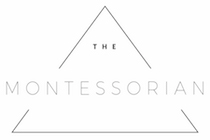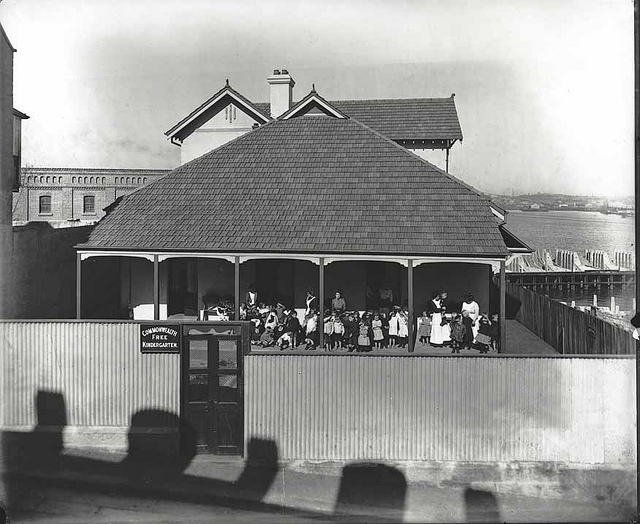Montessori’s libertarian philosophies about education impacted significantly on nineteenth and twenty-first century Australian history, at a time of social reform and a desire for democracy. That impact has remained, even though the Australian educational field moved away from authentic Montessori methods in favour of the New Education Movement.
“Australia in the 1890s was in the midst of an economic depression” (Feez, 2013, p. 42). As such, educated women that were committed to social reform established free kindergartens for poor children, including training teachers (Feez, 2013; Prochner, 2009). These women aimed to improve living conditions for the poor, alongside the government’s increasing reformation of primary school education to control child labour and care for neglected children (Feez, 2013). The kindergartens (based on Froebel’s theories of play-based learning) differed greatly from the teacher-directed rote-learning for the masses of infant classes originally established to relieve congestion in schools (Feez, 2013; Prochner, 2009). Nevertheless, Feez (2013) stated that by the 1890s and beginning of the twentieth century, variations of Froebel’s pedagogy were evident in the infant school pedagogies.
Like Froebel, Rousseau and Pestalozzi, Montessori’s methods place high significance on the freedom of the child (Feez, 2013; O’Donnell, 2007). However, many identify more similarities with the works of Itard and Séguin (Feez, 2013; O’Donnell, 2007; Simons & Simons, 1984). Understanding these approaches and their similarities with Montessori education assists in comprehending the appeal of liberty-based education in twentieth century Australia (Feez, 2013). Independence and freedom, as well as being fundamental philosophies of Montessori and Froebel education, are also significant ideologies of Anglo-Australian culture since European invasion and settlement with a focus on democracy and social reform (Feez, 2013; Kramer, 1988). As such, these aspects of Montessori education appealed to the twentieth century educators and continue to motivate parents and teachers to this day (Feez, 2013; Simons & Simons, 1984). Educators discovered that the progress children made through the liberty they were given could easily be transferred to other contexts, providing a real channel for children’s independence (Feez, 2013). “The Montessori system offered a program of reform to a reform-minded age …” (Kramer, 1988, p. 154).
Reverend Bertram Hawker of South Australia seems to have been the first Australian to see the Montessori system at work in a Casa dei Bambini in Rome (Feez, 2013). Hawker was a notable philanthropist and social reformer, helping the poor in Adelaide and London (Feez, 2013). Through his observations of children in kindergartens, he resolved that play was integral to children’s social, cultural and moral development (Feez, 2013). Consequently, Hawker invited Frances Newton (principal of the Sydney Kindergarten Training College at the time) to Adelaide to assist in starting the South Australian free kindergarten movement (Feez, 2013; O’Donnell, 2007). Lillian de Lissa accompanied her mentor, Frances Newton, in delivering lectures and presentations on kindergarten methods at Hawker’s home and the Exhibition Building (Feez, 2013; O’Donnell, 2007).
In 1911, Hawker visited a Casa dei Bambini and met Dr Montessori (Feez, 2013; O’Donnell, 2007). These experiences had such a strong impact on him that he remained in Italy before returning to England and founding their first Montessori classroom, in his own home (Feez, 2013; Kramer, 1988). He then established the Montessori Society of the United Kingdom in 1912, with much of London’s early childhood sector later teaching or advocating Montessori’s methods (Feez, 2013; Kramer, 1988). On Hawker’s return to Adelaide in March 1912, he imparted his new passion for Montessori’s methods to Lillian de Lissa, who subsequently returned to Sydney later that year to see the Blackfriars experiment, travelling on to to Rome for the 1914 Montessori course (Feez, 2013; Prochner, 2009).
Feez (2013) identified Martha Margaret Mildred Simpson as the educational leader who seems to be the earliest and most prominent advocate for Montessori education in Australia. She had opened an experimental classroom at Blackfriars School in New South Wales by mid-1912, influencing the spread of Montessori philosophies throughout Australia (Feez, 2013; O’Donnell, 2007; Prochner, 2009). Feez (2013, p. 39) noted, however, that a possible contributing factor to the success of the Blackfriars experiment was that “the first Australian Montessorians were trained and experienced teachers …”
Simpson travelled to Rome during the first international Montessori training course in 1913 to meet and learn from Montessori herself, remaining there two months (Feez, 2013; O’Donnell, 2007; Prochner, 2009). Four other experienced and trained Australian teachers also attended the course that year—Rhoda Selfe, Norma Selfe, Ruby Starling and Harriett Emily Barton (Feez, 2013; O’Donnell, 2007; Prochner, 2009). Ruby Starling had been persuaded by Reverend Hawker to attend Montessori’s course after meeting him and visiting his school (Feez, 2013). In 1913, Montessori’s training course and methods were frequently featured in Australian newspapers, including mention of the four Australian women attending the course at the time (Feez, 2013; Feez & Sims, 2014).
Feez (2013) suggested that the students returning from Montessori’s 2013 course would have been filled with hope and passion for what they had learnt. However, she also stated that the epoch they were returning to was “… far less attuned to their enthusiasm for educational reform based on liberty” (Feez, 2013, p. 88). Upon their return to Australia, the Selfe sisters gained employment as Montessori early childhood teachers, with Rhoda at Blackfriars and Norma at North Newtown Public School (Feez, 2013; Prochner, 2009). However, they did not approve of the way Martha Simpson had adapted Montessori’s methods, so chose to resign to open their own school rather than be moved to rural positions (Feez, 2013). They opened Warwick Montessori School in Ashfield, New South Wales in 1915, starting with 24 students and operating successfully for six years (Feez, 2013).
Ruby Starling, conversely, returned to the Kindergarten Union of New South Wales, opening their first experimental Montessori School in Pyrmont in 1915 with 12 students (Feez, 2013; Feez & Sims, 2014). Ruby’s school (dubbed ‘The Little Brown House’) was also a success, doubling in size over the next nine months, and requiring a waiting list (Feez, 2013). Feez (2013, p. 94) noted that with anti-German feelings raging due to the war, it was a “politically astute” move at the time by the Union to overshadow Froebel’s methods with those of Montessori. However, after family and societal tragedies during the war, Warwick Montessori School closed and The Little Brown House resumed its Frobel-inspired methods, later being renamed ‘Maybanke’ (Feez, 2013).
Neither Rhoda Selfe nor Ruby Starling appear to have taught Montessori education after the closure of their schools (Feez, 2013). Norma Selfe, in contrast, started a Montessori class at the Havilah Church of England Children’s home where she and Rhoda had been volunteering after their school’s closure (Feez, 2013). Norma was employed as the Kindergarten Leader by 1924, and utilised Montessori’s methods there until 1948 (Feez, 2013). Feez (2013) alleged that Norma’s Montessori Kindergarten class was possibly one of the most longstanding Montessori classes run by the same teacher in Australia’s centenary of Montessori Education.
After Lillian de Lissa’s introduction to Montessori education by Reverend Bertram Hawker, de Lissa explored the methods further through visiting various classes and schools across the globe and attending the second international training course in 1914 (Feez, 2013; O’Donnell, 2007; Prochner, 2009). On her way back to Adelaide from the training course, de Lissa visited Perth to present lectures on Montessori’s methods, which had a profound and immediate effect on their teacher training and kindergarten programmes (Feez, 2013; Prochner, 2009). In 1915 de Lissa started trialling the Montessori method in the free kindergartens of Adelaide, and gave lectures for the training college (Feez, 2013). By 1916, the Franklin Street Free Kindergarten was a Montessori Children’s House (Feez, 2013). It was such a success, de Lissa subsequently implemented Montessori’s methods at the Bowden and Halifax Street kindergartens too (Feez, 2013). In 1917 de Lissa returned to England to accept the position of first principal at the Gipsy Hill Training College, where she remained for 30 years (Feez, 2013; O’Donnell, 2007; Prochner, 2009).
Although de Lissa returned to England, her mark on Australian early childhood Montessori education would continue to grow (Prochner, 2009). After the great success of her experimental Montessori classrooms, the program was expanded until all of the Adelaide free kindergartens were Montessorian, and the training college had become the Kindergarten Montessori Training College by 1920 (Feez, 2013). College Montessori School was opened as a private school on the new premises of the training college in North Adelaide in 1918 (Feez, 2013). A graduate of the training college, Helen Jenkins, opened Sydney’s first private Montessori school in Croydon in 1920 (Feez, 2013). Feez (2013) identified that the Montessori program of the Kindergarten Union of western Australia was also expanding during the early 1920s. In 1922 they transferred the training college to West Perth and started a model Montessori kindergarten for children of three to eight years of age (Feez, 2013).
Reference List
- Feez, S. (2013). Montessori: The Australian Story. Sydney: NewSouth Publishing.
- Feez, S., & Sims, M. (2014). The Maybanke Lecture 2014 (pp. 1–58). Sydney: Sydney Community Foundation.
- Kramer, R. (1988). Maria Montessori: A Biography. Chicago: Da Capo Press.
- Montessori, M. (1912). The Montessori Method. English (American E.). Radford: Wilder Publications.
- O’Donnell, M. (2007). Maria Montessori. (R. Bailey, Ed.). London: Bloomsbury Academic.
- Prochner, L. (2009). A History of Early Childhood Education in Canada, Australia, and New Zealand. Vancouver.
- Simons, J. A., & Simons, F. A. (1984). Montessori and Regular Preschools: A Comparison. Urbana.



